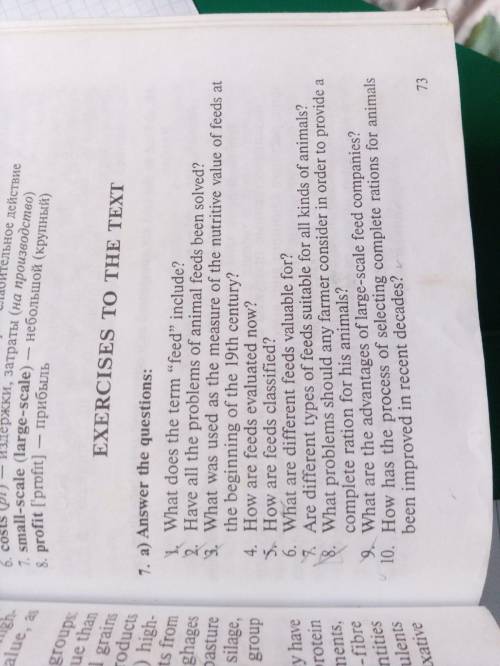ответьте на вопросы ANIMAL FEEDS
Animal feeds include any feedstuff which is grown or developed for livestock and poultry. The main aim of a farmer is to provide animals with as highly nutritional diets as possible in order to maintain them healthy and ensure the quality of such final animal products as meat, milk, or eggs. Even today the problem of feeds is still a subject of study for agricultural scientists.
Proteins, carbohydrates, fats, minerals and vitamins are known as the basic nutrients that animals require for growth, reproduction, and good health, but the amount of these substances varies greatly with the type of feed. The first effort to evaluate feeds for animals on a comparative basis was made by Albrecht Thaer (1752-1828), in Germany, who developed "hay values" as measures of nutritive value of feeds. Tables of the value of feeds and of the requirements of animals were first drawn up in Germany; later they were used in other countries as well.
Present-day knowledge represents an expansion and further improvement of these early efforts. The usual chemical analyses of feeds provide information on the total amount of dry matter, protein, fat, fibre, and ash4 contained in the feed. Energy value, mineral elements, and vitamins are also determined; these values are included in complete tables of feed composition. The better methods for chemical analyses of feeds are developed, the more reliable data are obtained for calculating feeding rations for animals.
Animal feeds are classified according to: 1) the origin, that is, plant or animal origin of feeds; 2) the chemical composition, such as high-protein, high-fibre, high-moisture etc; 3) the nutritional value, as concentrates and bulky feeds.
Generally, animal feeds may be classified into two large groups: concentrates and roughages. The former are higher in energy value than the latter and are subdivided into the following types: 1) cereal grains such as wheat, corn (maize), oats, rye, barley and their by-products which remain after grain has been processed for human use, 2) high-protein oil meals or cakes from soybeans, sorghum, 3) by-products from processing of sugar beets, 4) animal and fish by-products. Roughages include such feeds as: 1) green roughages (clover, timothy, other pasture grasses and legumes), 2) dry roughages or fodder (hays, straws); 3) silage, 4) root crops. Green forage grasses, silage and roots comprise a group of succulent feeds which are high in moisture.
Concentrates are valuable in feeding all classes of animals as they have a high food value relative to volume, that is, they are rich in both protein and carbohydrates as well, they contain a number of microelements, minerals and vitamins. Roughages are bulky feeds with high-fibre content which is poorly digestible. Thus, they are fed in large quantities to cattle and sheep but they are not suitable for feeding pigs. Succulents are known as palatable feeds but contain a lot of water and have a laxative effect. The younger the grass is, the higher it is in vitamins and minerals, so farmers start grazing cattle and sheep as early in spring as possible. The quality of silage and its nutritive value is greatly affected by a number of factors such as the type of a forage crop, the plant age and storage conditions. Roots are low in protein but high in carbohydrates and moisture, so they are often used as supplements to hay and straw in order to provide complete rations for cattle and sheep.
Feeds vary not only in the amount of nutrients but in costs from season to season. Thus, it is important for a farmer to select feed ingredients for complete rations as economically as possible. Nowadays large-scale commercial livestock companies as well as small-scale producers widely use special computer programmes for selecting feed mixtures that will satisfy the nutrient requirements of a specific type of animal at a particular stage of development. The more palatable and nutritious rations are provided for animals on the basis of the lower-cost feeds, the higher profits a farmer can get.

Ответы
Показать ответы (3)
Другие вопросы по теме Английский язык
Популярные вопросы
- Y=2x+1 x=2 x=3 y=0 вычислить площадь фигуры ограниченной линиями...
1 - Почему в конце слова «происходят» пишется буква «я»?...
3 - На какой вопрос отвечает слово занятии ? если для ответа нужно обязательно словосочетание...
2 - Тайга кормилица хлипких не любит чьи это слова объясните что это значит что сделал...
1 - [tex] \frac{1 + 2}{x} - \frac{2}{2x} [/tex]...
3 - Погані ситуації у школі між однокласниками невелике оповидання...
2 - Разберите (синтаксический разбор) предложение цветы и травы умывались дождем, тянулись...
1 - Вкаком слове буква ё обозначает два звука? жжёт, найдёт, жёлтого, ...
2 - Привлекая обществоведческие знания, составьте краткое (из 5–7 предложений) сообщение...
1 - Вдвух цистернах было поровну воды. когда из первой цистерны взяли 10 л воды, а из...
2